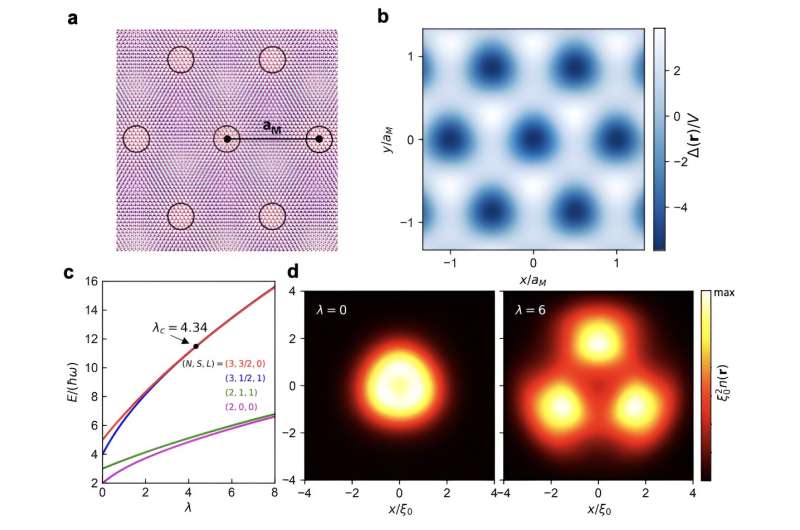February 4, 2024 feature
This article has been reviewed according to Science X's editorial process and policies. Editors have highlighted the following attributes while ensuring the content's credibility:
fact-checked
peer-reviewed publication
trusted source
proofread
Exploring new physics arising from electron interactions in semiconductor moiré superlattices

Semiconductor moiré superlattices are fascinating material structures that have been found to be promising for studying correlated electron states and quantum physics phenomena. These structures, made up of artificial atom arrays arranged in a so-called moiré configuration, are highly tunable and characterized by strong electron interactions.
Researchers at Massachusetts Institute of Technology (MIT) recently carried out a study further exploring these materials and their underlying physics. Their paper, published in Physical Review Letters, introduces a new theoretical framework that could inform the study of large-period moiré superlattices, which are characterized by weakly interacting electrons residing in different potential wells.
"Our group has been working on two-dimensional semiconductor moiré materials for five years," Liang Fu, co-author of the paper, told Phys.org. "In these systems, electrons move in a periodic potential landscape (the moiré superlattice) and interact with each other through Coulomb repulsion."
The primary advantage of semiconducting moiré superlattices is that they can easily be manipulated in experimental settings. Specifically, physicists can control the density of electrons within them to alter the property of their many-electron ground state.
"Most previous studies have focused on the case of containing one or less than one electron per moiré unit cell," Fu said. "We decided to explore the multi-electron regime and see if there is anything new."
Predicting the behavior of multi-electron materials can be very challenging. The main reason for this is that these systems often contain various energy scales which compete with one another.
"Kinetic energy favors an electron liquid, while interaction and potential energy favors electron solid," Aidan Reddy, first author of the paper, explained. "The nice thing about moiré materials is that the relative strength of different energy scales can be tuned by varying the moiré period. Taking advantage of this tunability, we developed a theoretical framework to study large-period moiré systems, where electrons residing on different potential wells are weakly coupled."
The theoretical framework introduced by this team of researchers focuses on the behavior of individual atoms in the moiré superlattice. Reddy, Fu and their colleague Trithep Devakul found that this relatively simple approach could still help to shed light on various interesting quantum physics phenomena.
Using their framework, the researchers unveiled new physics that could be observed in multi-electron semiconductor-based moiré superlattices. For instance, at a filling factor n=3 (i.e., when each moiré' atom in a superlattice contains three electrons) they found that Coulomb interactions led to the formation of a so-called "Wigner molecule." In addition, under specific circumstances (i.e., if their size is comparable to the moiré period), they showed that these Wigner molecules could form a unique structure known as an emergent Kagome lattice.
The interesting self-organized electron configurations outlined in this research team's paper could soon be further explored in follow-up studies. In addition, these newly uncovered configurations could serve as an inspiration for other physicists, allowing them to study charge order and quantum magnetism in a regime quite unfamiliar to conventional materials.
"The most notable insight of our work is that, at special filling factors, electrons self-organize into striking configurations (Wigner molecules) due to a balance between the energy scales at play. Our prediction of Wigner solid has been confirmed experimentally," Trithep added.
In the near term, the researchers plan to study the quantum phase transition between Wigner electron solids and electron liquids.
More information: Aidan P. Reddy et al, Artificial Atoms, Wigner Molecules, and an Emergent Kagome Lattice in Semiconductor Moiré Superlattices, Physical Review Letters (2023). DOI: 10.1103/PhysRevLett.131.246501
Hongyuan Li et al, Wigner Molecular Crystals from Multi-electron Moiré Artificial Atoms, arXiv (2023). DOI: 10.48550/arxiv.2312.07607
Journal information: Physical Review Letters , arXiv
© 2024 Science X Network




















